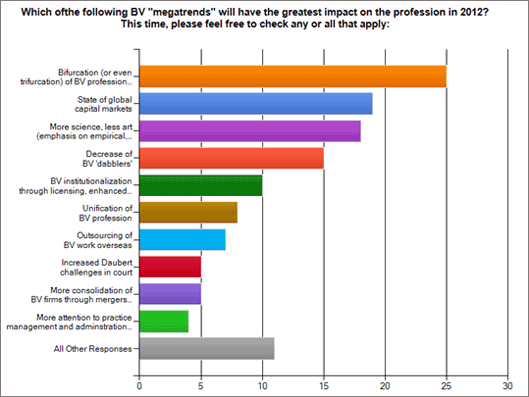
| December 21, 2011 | Issue #111-3 |
Valuation professionals lack unified identity, says SEC, in call for unified standards and credentials “Valuation professionals stand apart from other significant contributors to the financial reporting process for . . . their lack of a unified identity,” said Paul Beswick, deputy chief accountant for the SEC, in his opening remarks at last week’s 2011 AICPA National Conference on Current SEC and PCAOB Developments in Washington, D.C.:
As regulators, the SEC continues to see valuation analyses that “do not measure up,” Beswick added, citing methodologies that lack conceptual merit and support. To rebuild public trust in the valuation profession, he suggests a single set of qualifications and a unified standard of practice and ethical conduct. “One could also contemplate whether a comprehensive inspection program and a fair disciplinary mechanism should be established to encourage proper behavior and enforce the rules of the profession in the public interest,” said Beswick, who also spoke on the more predictable topic of IFRS convergence. For a complete copy of his remarks, click here. Tax affecting has stalled in the courts, but defined value clauses gained traction in 2011 In his 5th annual address on Recent Developments in Federal Tax Valuations held in Portland, Ore., last week, Professor Jack Bogdanski (Lewis and Clark Law School) discussed three “big victories” for taxpayers in the courts this year:
“Tax affecting is not going anywhere,” Bogdanski also told the audience of attorneys and appraisers. “When valuing S corp stock, tweak the discount rate but don’t call it tax affecting.” BV profession in 2012: more specialization, more science The current state of the economy may have had the most impact on BV practices in 2011, according to our annual end-of-the-year survey. But as domestic and global markets stabilize, the increasing specialization of the BV profession should have the greater influence in the year ahead, say survey respondents, who are also feeling the emphasis (by courts, regulators, and clients) on more empirical analyses:
Compare these results to our 2010 survey, in which well over half (57%) of respondents believed that the convergence of U.S. and international financial reporting standards would have the greatest impact in 2011. (Fewer than 7% did this year, so their answers were grouped with “all others.”) Likewise, over half (52%) of last year’s participants thought that the promulgation of international standards would be a BV-shaping trend in 2011, compared to only 4% this year. BV institutionalization was also much more of a concern, as was the emphasis on empirical methods and data (57% of 2010 respondents ticked off those two items). Over 30% believed that BV firms would pay more attention to practice management this year—but macro-economic concerns seem to have eclipsed this micro-focus for the near future. Our thanks to all who participated in the latest survey, which tallied more responses than in any prior year We’ll have a full write up of results and commentary in the Feb. 2012 Business Valuation Update. More questions re: IPEV’s entity-level approach to DLOM In response to our item last week on the IPEV guidelines’ approach to applying a marketability discount to PE and VC valuations, Rod Burkert (Burkert Valuation Advisors) writes: “A DLOM is normally taken at the subject-interest level—not at the (100%) entity level or the (100%) equity level—because you are trying to estimate the marketability/transferability of a particular interest, not the company itself. “In fact, there is no unanimous agreement in the profession as to whether a DLOM should be applied for a 100% interest (entity or equity level),” Burkert adds. “So, the IPEV approach would make one believe that a pro rata DLOM, if taken at the entity level, is valid for a 100% interest or a 1% interest . . . or anywhere in between. I don't see how that can be true.” Best practices in e-discovery, brought to you by the NY Bar The E-Discovery Committee of the Commercial and Federal Litigation Section of the New York State Bar Association recently issued its “Best Practices in E-Discovery in New York State and Federal Courts.” The report offers 14 “guidelines” for state and federal litigators dealing with electronically stored information (ESI), and includes a helpful glossary and bibliography as well as a brief and straightforward interpretation of current law and recommendations. The 14 guidelines address the following topics:
In sum, this report “succeeds as a . . . helpful primer” for attorneys and analysts on how to “best” navigate the e-discovery landscape, says the latest e-discovery alert by Gibson Dunn attorneys. “The guidelines present an excellent, basic checklist of common e-discovery concepts and issues that arise in state and federal court litigations.” FASB’s Seidman outlines five-point plan for IFRS convergence International accounting standards and private company reporting are “two of the most important issues facing our profession, our capital markets, and our companies,” FASB chair Leslie Seidman said in her remarks to the AICPA national conference on SEC and PCAOB issues last week. Although the convergence process has advanced global financial reporting in several key areas, Seidman believes that a “side-by-side convergence model is not . . . optimal.” Instead, she outlined a five-point approach:
As to the second “elephant in the room”—private accounting standards—Seidman said the FASB has declined to establish a new, separate board to set GAAP for private companies. Instead, the Board’s parent company, the Financial Accounting Foundation (FAF) will propose a Private Company Standards Improvement Council, to be chaired by a FASB member and reporting to the FAF trustees (see BVWire #109-2). “Underlying this recommendation is the FAF’s belief that, over time, the standards of two entirely separate boards will inevitably diverge, despite their best intentions,” Seidman added, encouraging all interested parties to share their views with the FAF “on this important issue” by Jan. 14, 2012. For the complete text of Seidman’s remarks, click here. Uniloc expert fails to analyze licenses that are sufficiently comparable To calculate reasonable royalty damages for patent infringement, financial experts must now comply with the tighter Uniloc v. Microsoft standard, which only permits reliance on comparable licenses with a “discernible link to the claimed technology.” This link must account for both the technological and economic differences between the prior licenses and the patents-in-suit. Ironically, the same expert whose analysis failed in Uniloc appeared in a new case out of the federal district court in California. To calculate reasonable royalty damages for infringement of mobile phone technology, he relied on two comparable licenses that were technologically but not economically similar. In fact, the expert apparently provided “no analysis at all of the economic differences between the significant patent agreements,” the court held, and excluded his testimony under Daubert. The expert “bears the burden of proving comparability,” the court added, noting that simply picking a low royalty rate will not cure “a faulty damages analysis.” However, the court approved the expert’s application of the entire market value rule, and permitted him to “repair and prepare” a Uniloc-compliant analysis prior to trial. Look for the complete digest of Dataquill Ltd. v. High Tech Computer Corp. 2011 U.S. Dist. LEXIS 138565 (Dec. 1, 2011) in the Feb. 2012 Business Valuation Update; the court’s opinion will be available soon at BVLaw. ktMINE reaches new milestone. ktMINE—a unique, interactive, intellectual property database—now offers 11,000 full-text IP license agreements, including their non-redacted, variable royalty rate information. With precise search functionality and robust data-drilling capabilities, ktMINE lets you quickly find and analyze market comparables from a goldmine of IP licenses and documents. For more information, visit ktMINE or contact Randy Cochran. Exclusive opportunity to question Dr. Comment on his DLOM conclusions As noted in a recent BVWire, a paper by Prof. Robert Comment (Johns Hopkins) on the “redundancy” of DLOM calculations has started a fierce debate and defense of DLOM methods in the BV profession. To hear a full and fair airing of Dr. Comment’s views—and get an opportunity to ask specific questions about his research and conclusions—don’t miss the first BVR webinar of 2012, Why Your DLOM is Vulnerable to a Daubert Challenge, on Thursday, Jan. 12, 2012. Next year will also see a return of BVR’s groundbreaking Online Symposium on Healthcare Valuation. This monthly series of cutting-edge programming begins with an Economic & Regulatory Update on Jan. 24, 2012, featuring series curator Mark Dietrich. It will be followed by The Valuation of Hospitals on Feb. 28, 2012, featuring Don Barbo and Robbie Mundy. Subscribers to all 12 programs receive not only an estimated 24 CPE credits, but also access to BVR’s Healthcare Desktop Learning Center, an online multimedia library of all healthcare webinars dating back to 2002, including the entire 2011 Symposium. For more information on the 2012 Symposium, click here. Note the change of date: The Advanced Workshop on Monte-Carlo Simulations, featuring David Dufendach and Jason Andrews (both Grant Thornton), originally scheduled for Jan. 26, 2012, will now air on March 8, 2012. IASB/FASB issue Common Offsetting Disclosure Requirements In more convergence news, last Friday the IASB and FASB released common disclosure requirements intended to help investors and other financial statement users “better assess the effect or potential effect of offsetting arrangements on a company’s financial position,” says a joint release. In response to feedback from their respective stakeholders, the boards decided to retain their existing offsetting models, supplemented by these new disclosure requirements to allow investors “to better compare financial statements prepared in accordance with IFRSs or US GAAP.” “These disclosures will help investors to bridge differences in the offsetting reporting requirements of IFRSs and US GAAP, while the additional requirements will also provide better information on how companies mitigate credit risk related to offsetting,” says IASB chair Hans Hoogervorst. “That said, using disclosures to bridge differences in offsetting requirements was plan ‘B’ for both boards.” Best wishes from BVR BVWire would like to end this last issue for 2011 with a note of celebration and thanks to all our readers. We will resume our first issue of 2012 on January 4th. Here’s wishing all of our good friends personal joy and professional success in the coming New Year!
To ensure this email is delivered to your inbox, please add editor@bvwire.com to your e-mail address book. We respect your online time and privacy and pledge not to abuse this medium. To unsubscribe to BVWire™ reply to this e-mail with 'REMOVE BVWire' in the subject line or use the link below. This email was sent to %%emailaddress%% Copyright © 2011 by Business Valuation Resources, LLC |
|



